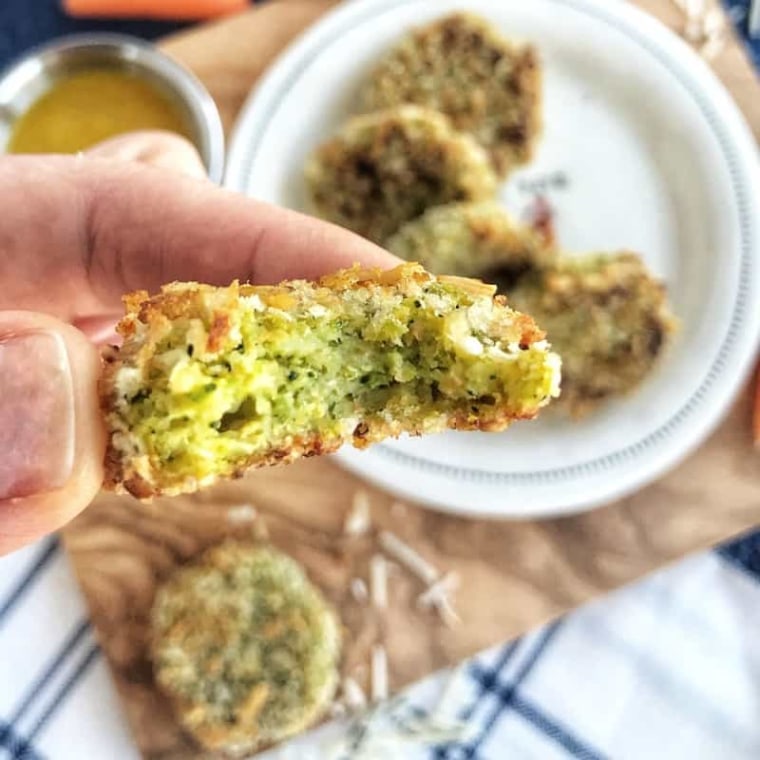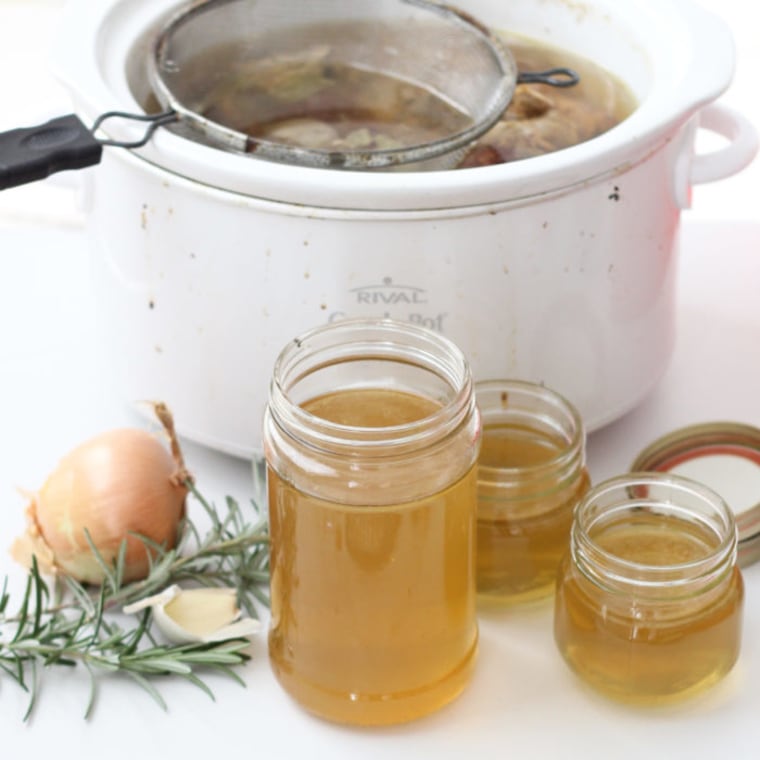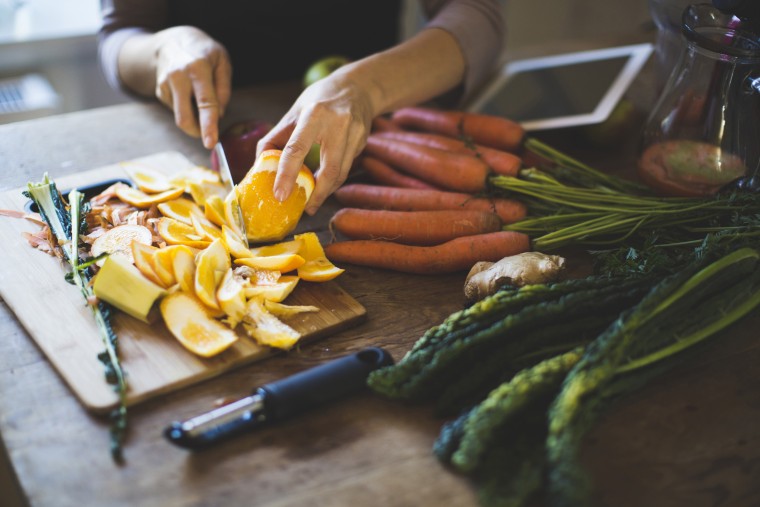Approximately 133 billion pounds of food — or $161 billion worth of food — is wasted each year in the United States.
You may not think you personally are having much of an impact, but take a closer look at your garbage: orange peels, broccoli stalks, the carcass of the rotisserie chicken you bought for dinner. Yes, all of those things count.
You already know that excess food can be donated to a local food bank (use the tool at Feeding America to find a pantry near you). But what about making use of all of those food scraps that end up in the trash? Composting is an obvious and great place to start. But it turns out you can use scraps — like those citrus peels, melon rinds and cauliflower stems you’d normally toss — to whip up delightfully unique and nutritious recipes. These tips will help you waste less of the foods you cook with and lower your grocery bill, too.
Add pulp to muffins
“When squeezing juice in my juicer, I add the pulp to homemade muffins to boost the fiber and natural sweetness,” says Abbey Sharp, RD, a dietitian in Toronto and author of the The Mindful Glow Cookbook. Here’s how to do it: Add 1 cup of pulp per 1 ½ cups of flour to your favorite muffin recipe.

Don’t forget the stalks
You can do so much with broccoli and cauliflower stalks. “We cut off the stalks and slice them into chips for crudité,” say Tammy Lakatos Shames, RDN, CFT and Lyssie Lakatos, RDN, CFT, co-authors of The Nutrition Twins' Veggie Cure. “The stalks contain more fiber than the florets, so they make a delicious, crunchy and creative alternative to traditional veggies for dipping.” Some more ideas: Spiralize them into noodles, shred them into a slaw or process them into veggie nuggets.
Make use of melon rind
You might think that the fruit of the watermelon is the best part. But the rind is totally edible and packs a nutritious punch, delivering immunity-helping vitamin C and other nutrients. “Use the rind by cutting it into chunks or shredding it and adding to stir fries,” suggests Holley Grainger, MS, RD, a dietitian in Birmingham, Alabama. You can also eat it as is or pickle it for later use (pickled rinds add an unexpected zing to salads!).
Blend fruit scraps into smoothies
“I like to make smoothie bags using fruit scraps,” says Frances Largeman-Roth, RDN, a dietitian in Brooklyn, New York, and author of Eating in Color. “For example, if I’m cutting up a pineapple or melon for a fruit salad, there are always some odd bits left over. I’ll throw these into a freezer bag, which locks in the fruit’s nutrients, and add a banana and some greens and pop it in the freezer.” When it’s smoothie time, toss the contents of the bag into a high-speed blender, and add nut butter and milk or juice. “Voila!” says Largeman-Roth. “Food waste is reduced, and my healthy smoothie work is already done for me.”
Bake with near-spoiled fruits

“I'm an avid baker, and I often lean on the fruits in my fridge that are past their prime to toss into breads, cakes, muffins and more,” says Regan Jones, RD, a podcaster and blogger at This Unmillennial Life. “Citrus does an especially nice job of livening up baked goods. And even choices like berries can make a fun addition to a pan of brownies.” Brown bananas are more sugary than their fresher counterparts and also do a great job of naturally sweetening desserts, such as a vegan chocolate pudding.
Turn bruised apples into a compote
We’ve all crossed paths with an apple that looks like it isn’t worth eating. But think twice before you toss it. “Apples never get wasted at my house,” says Jones, who advises chopping up any part that isn't badly bruised and tossing with a pinch of cinnamon and the slightest bit of brown sugar. “Then add a little water, and simmer in a saucepan until thick,” she says. “You've got a warm fruit topping for oatmeal or the perfect side to grilled meat.” You can also make a mean applesauce with bruised apples.
Add citrus peels to everything
Snacking on an orange or slicing a lemon to flavor water? Zest the peels. If you don’t have an immediate use for citrus zest, store it in the freezer in a zip-top bag. “Rather than tossing citrus peels, we use them in smoothies and grated over salads and on sandwiches and cooked grains for a refreshing zest that packs in antioxidants and fiber,” say Lakatos Shames and Lakatos. You can also process zest into a fruit-based “nice cream” or use it to top off a yogurt or cottage cheese parfait. The peels contain a lot of nutrients, from vitamin C to disease-fighting phytochemicals, shows a study by researchers in India.

Turn chicken carcass into soup
“Rotisserie chickens have been darlings of the prepared-food scene for years,” says Robin Plotkin, RDN, a culinary nutritionist in Dallas, Texas. “So many people throw out the carcass. Don’t. That’s the beautiful beginning of a delicious, flavorful homemade chicken soup.” Making such a soup is much easier than you’d think: Fill a stockpot with water, the carcass, carrots, celery, onions, parsley, salt and black pepper, advises Plotkin. “Bubble away for a few hours, and the flavor imparted from the bones is better than any store-bought broth,” Want precise instructions? Try this homemade chicken broth recipe.
Save the stems
“There’s nothing wrong with the outer layer of cabbages, lettuces and even cauliflower leaves and carrot skin,” says Plotkin. “Same thing goes for stems of herbs, kale and chard. The same vitamins, minerals and fiber you find in the hearts of these veggies can be found in their leaves, stems and stalks.” Sautee up some of those greens, grill them or shred them into slaws or salads. Herb stems make a tasty compound butter.
WHAT A NUTRITIONIST WANTS YOU TO KNOW
- Bad nutrition advice dietitians want you to forget
- The best way to lose weight boils down to these three things
- What you need to know about going vegan
- What is healthier: natural sugar, table sugar or artificial sweeteners?
- The healthier pick: a hot dog or a hamburger?
Want more tips like these? NBC News BETTER is obsessed with finding easier, healthier and smarter ways to live. Sign up for our newsletter and follow us on Facebook, Twitter and Instagram.
